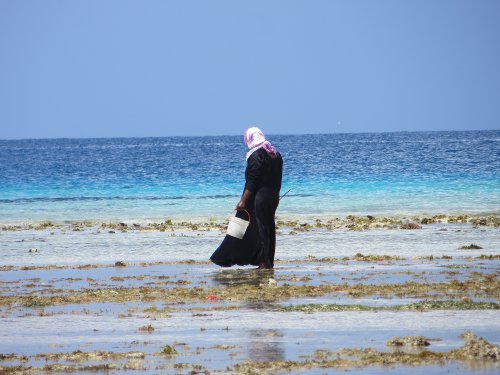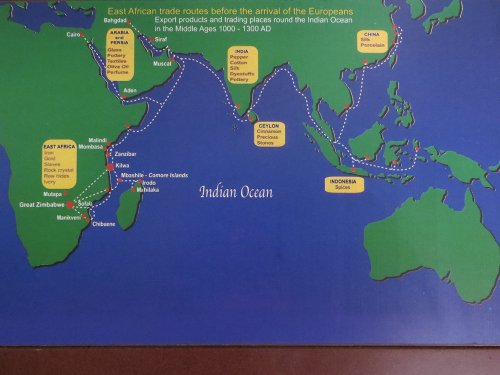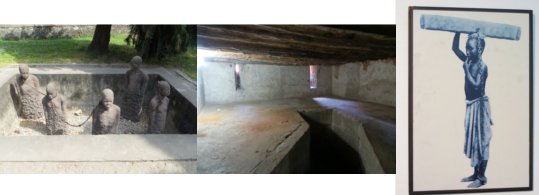Zanzibar – A Historic Trip in Paradise
We embarked on a ferry from Dar Es Salaam to Zanzibar on January 30, 2014 and spent 6 days enjoying the island. From Stone Town, we headed north on a dallas-dallas, minibus, to Nungwi beach for four nights. Our stay by this white sand paradise of turquoise waters in the Indian Ocean was definitely a vacation from our vacation. One morning during low tide, we walked on the beach following the steps of local women and children that collect oysters, octopus, eels, fish, and other seafood. The ocean had revealed its skeleton, exposing corals of different shapes, star fish of vibrant colors, urchin, and anemone serving as homes to clown fish.


On another day, we embarked on a dhow, a traditional wooden boat, to Mnemba Island, and enjoyed this natural reserve by snorkeling near the shores for hours. We were amazed at how much diversity and marine life we could see while swimming on the surface! From Nungwi Beach we also ventured on a scuba diving trip, completing two immersions at Hunga and Mwana wa Mwana. The diving experience was filled with spectacular coral formations, fishes, and eels. Every day, after each aquatic adventure, we enjoyed the late afternoon bathing and playing in the transparent waters of this paradise just a few steps from our room. Life was good in Zanzibar!
Nungwi Beach at Low Tide


Sea Urchin at Low Tide
School of Fish
School of Fish
After resting for a few days on the north of the island, we returned to Stone Town in a dallas-dallas. These minibuses are not only the most affordable way to travel around the island but probably a one-time-opportunity of interacting with the locals. The journey gave us the view of the towns along the road and meaningful memories. One recollection in particular, a little boy sitting next to Sal was getting car sick and vomited everywhere, including on his neighbors! Despite of this minor discomfort that caused all passengers around him to get involved, seeing the solidarity of Tanzania people was greater. Everybody around did the best they could to assist the boy and help his father to clean up. We were impressed seeing another young man traveling in the bus, which was not related to the boy or knew him at all, holding a plastic bag for him during the rest of the journey. We also did our best to help by providing plastic bags. Sal will never regret traveling next to the child, nothing brings greater joy to him than children 🙂
Back in Stone Town, we loved getting lost along the labyrinth streets of Arabic style architecture, walking next to the local women and men in their traditional Muslim clothing, and tasting delicious sugar cane juice, Zanzibar pizza, and grilled octopus at the night food market in Forodhani Gardens. We were lucky to attend a performance of Taraab music which was sublime, the sounds of their traditional instruments and lyrics went directly into our souls. During our two days in the town, we also visited the Palace Museum, the Old Slave Market, the Hamamni Persian Baths, and the Museum of Zanzibar. All these places offered us the opportunity to discover the history and culture of Zanzibar Island, which is part of the Swahili coast where the continental world of Africa meets the maritime world of the Indian Ocean. The Swahili coast is a thin strip of land, about 15 km (10 miles) wide, extending from Southern Somalia to Northern Mozambique, and includes the Comoro Islands and the Northern tip of Madagascar.

For hundreds of years these two worlds have been interacting with each other, giving rise to a cosmopolitan culture and a mixed population that is so characteristic of the Swahili civilization. Different features unite the coast, foremost is the language, Swahili, as well as the religion, Islam, which underlines a traditional system of belief, cultural practices, rituals, dressing, and architecture. These similarities have been intensified over the centuries by strong economic, social, and cultural interrelations between the Swahili coast and across the Indian Ocean with Arabia and the west coast of India. The island of Zanzibar has been historically an important epicenter of these two world’s interactions.

Zanzibar developed as the metropolis of East Africa during the first half of the 19th century. This period is associated with the rule of Seyyid Said Sultan, ruler of Oman and Zanzibar between 1806 and 1856. During this period, there was enormous growth in the external trade of Zanzibar and in the production of cloves which was to become the staple of the island. The whole trading of East Africa was centralized in Zanzibar and grew in ivory, slaves, and cloves. Commercial treaties were signed with Western nations, starting with United Stated of America in 1833. After the death of the Seyyid Said Sultan, Zanzibar was separated from Oman and in 1862 the two became independent sultanate under two sons of Seyyid Said. The tour around the Palace Museum offered interesting objects of the time and told the story of one of the daughters of Seyyid Said Sultan, Princess Salme, who secretly taught herself how to write. She migrated to Europe, got married to a German businessman, and became the first female writer from East Africa in the 19th century.
During our stay in Stone Town, we also visited the last world’s open slave market. In the market, many men, women, and children from East and Central Africa lost their freedom. The human trade was stopped by the Sultan of Zanzibar on June 6, 1873, following the appeal made by Dr. David Livingstone in 1857 to the Universities of Oxford and Cambridge to liberate Africa from slavery.

The Cathedral Church of Christ was subsequently built there by Bishop Edward Steere in 1874, in the exact place where the slave auction used to happen. The total number of Africans whom were slaved, sold, and lost their lives there is unknown. The underground chambers in which the slaves were secluded are horrifying. When we visited them, the chambers were empty and yet breathing there was challenging, the experience of sitting there for a few minutes brought tears to our eyes. Without proper ventilation, light, food, and toilets, many Africans were kept chained there before the auction. During high tied, the ocean will filtered into the chambers and some slaves would drown. Many of them died from suffocation, abuse, and malnutrition. The price of a human being was determined by their “strength”, which was brutally measured by their capacity to endure public whippings without crying. Children were separated from their parents and added as a bonus to customers purchasing a high number of slaves. Even after the abolition of the slave market, an illegal market continued taking place for another 30 years and slaves were still taken from Eastern and Central Africa to Zanzibar, where they were hidden in a natural cave in the island.
Zanzibar Island is without question an exceptional place to visit, offering a unique natural beauty, history, and culture to experience. A mix of oceanic pleasures and the sadness of slavery still navigate around our thoughts. The amount of pain and suffering endured by the African people is incalculable. Zanzibar was the exiting port for many Africans that were taken to the Americas during colonization. Our heritage and identity is attached to their tragedy in so many ways, we are deeply close to this chapter of history. Enough words will never exist to express sorrow and disapproval for what was done. Nobody could forgive or forget the cruelty caused by human kind. After the anger and the sadness that provoked us, we welcomed the opportunity of having a greater awareness of who we are in essence and the most profound appreciation towards the liberty we withhold. Africa lives within us, we are so happy to finally be back in the motherland!
